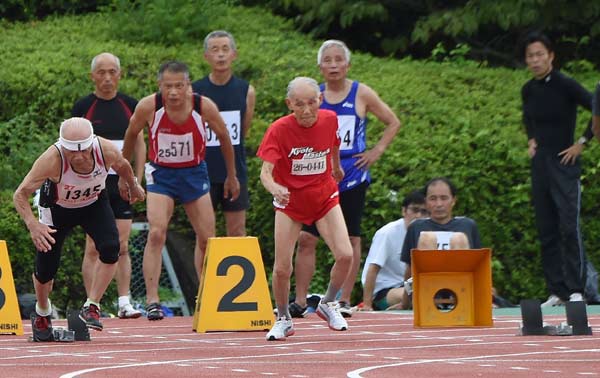CAI HONG
(China Daily) Updated: 2015-09-28 07:57
 |
|
103-year-old Japanese sprinter Hidekichi Miyazaki (2nd left) runs during men's 100m dash at a Japan Masters Athletics competition in Kyoto on Aug 3. Miyazaki, who holds the 100 metres world record for centenarians at 29.83 seconds and is dubbed 'Golden Bolt' after the Jamaican flyer, plans to wait another five years for his dream race. [Photo/Agencies] |
At an athletics tournament last week 105-year-old Hidekichi Miyazaki broke into the record books with a 42.22-second dash in the 100m and raced into the Guinness World Records as the fastest man in the world in the over-105 age category.
Japan, which marked "Respect for the Aged Day" on Sept 21, has the highest number of people over 65 years old. The number of people over 80 has crossed 10 million with 60,000 of them being more than 100 years old, according to Japan's Ministry of Internal Affairs.
Japan should be proud of its people who live longer than their peers in the rest of the world. But their longevity also comes with problems.
By 2025, Japan's Ministry of Labor, Health and Welfare projects, the country's expenditure on healthcare will rise 70 percent, nursing home care by 160 percent and pensions by 40 percent.
These spending hikes are not the result of inflation but a rapidly aging society.
From 1970 through 1995 Japan moved from being an "aging" to an "aged" country, according to a definition used by the Asian Development Bank and the United Nations. In 2006, with more than 20 percent of its population being more than 65 years old, Japan became the first super-aged country in the world.
Japan's 2014 census showed that its population dropped for the sixth year in a row to reach a historic low. People over 65 now account for 25.9 percent of the population-the first time this group has exceeded a quarter of the total since 1968.
For about 50 years after World War II the combination of Japan's fast-growing labor force and the rising productivity of its famously industrious workers created a growth miracle. Within two generations the number of working-age people increased by 37 million and Japan emerged from the ruins of war to become the world's second-largest economy-overtaken by China in 2010. In the next 40 years, the process is likely to go into reverse. Japan's working-age population will shrink so fast that by 2050 it will be less than what it was in 1950.
On Thursday, Japanese Prime Minister Shinzo Abe announced his new plan to revive the country's economy. It includes support for parenting and childcare and improved social security to lighten the burden of child and elderly care for struggling families. He also set a target for increasing the birth rate to 18 children per 10 women from the current very low rate of 14.
But Japanese policymakers need to realize that these moves are not going to immediately halt the population decline.
John Beard, director of the Department of Ageing and Life Course at the World Health Organization, has said that there is no need to become overly gloomy because of the demographic change. The WHO official sees aging as an opportunity despite the pressure it exerts on social security systems.
I agree, as I am amazed and moved to see people in their 70s and 80s in Japan looking healthy and holding high-pressure jobs. The secret to the health and agility is working out regularly and having a purpose in life.
Sprinter Miyazaki believes his best is yet to come. "I can't think about retiring," said the centenarian. He is serious, for he has already entered his name for the Japanese masters championships next month.
Hats off to the old folks.
The author is China Daily's Tokyo bureau chief. caihong@chinadaily.com.cn

I’ve lived in China for quite a considerable time including my graduate school years, travelled and worked in a few cities and still choose my destination taking into consideration the density of smog or PM2.5 particulate matter in the region.